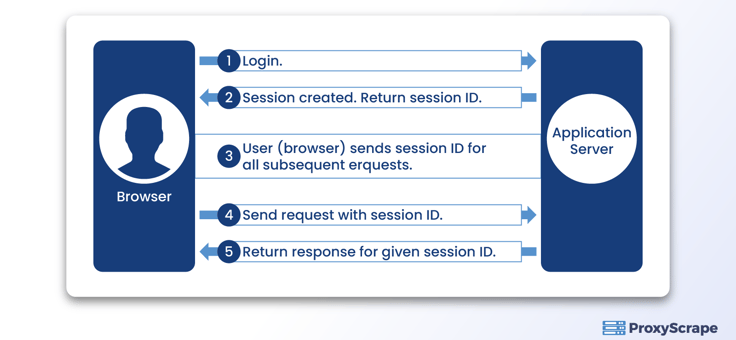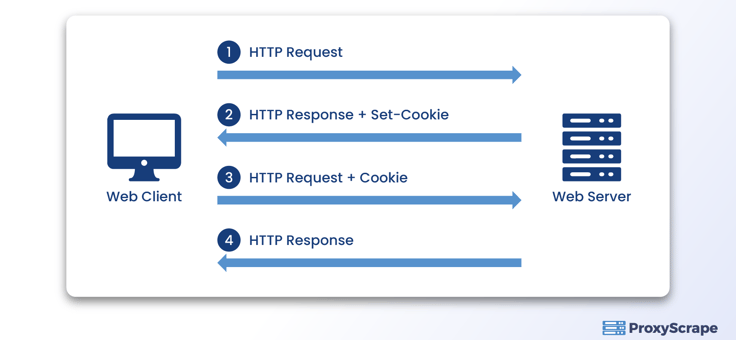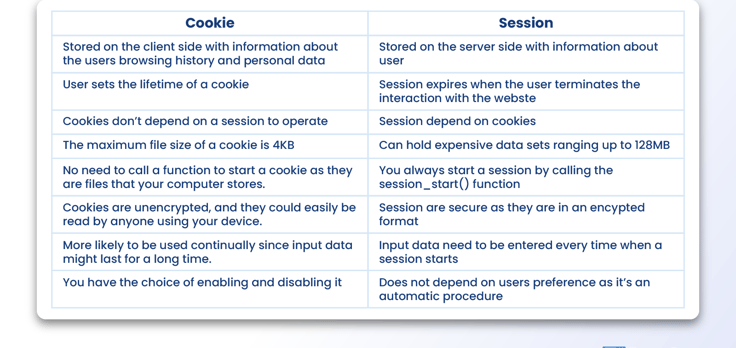Sessions And Cookies In Web Scraping

You can not overlook Sessions and cookies in the web scraping field. Most web applications depend on sessions and cookies to remember each distinct user to provide them with a better user experience. But what exactly are sessions and cookies in the world of web programming, and how do they function? In this article, we”ll
You can not overlook Sessions and cookies in the web scraping field. Most web applications depend on sessions and cookies to remember each distinct user to provide them with a better user experience.
But what exactly are sessions and cookies in the world of web programming, and how do they function? In this article, we”ll answer all those questions before moving on to how you use sessions and cookies in web scraping. Firstly, we’ll begin with sessions.
Let’s dive in, folks!
What are the sessions on the web?
In more straightforward terms, a session is simply a series of user interactions between your device and the server it connects to. The duration of a session can be from the time that a device establishes communication with a server. A session then terminates when a user completes a connection with a web application.
On the other hand, there can be sessions that the timer invokes when a user starts visiting a website. A web server sets these timers for a specific period, and the session expires when the timer eases.
.
A session can be divided into:
- Stateful: At least one of the parties preserves information regarding the communication. This means when a client establishes a communication with the server, it serves the user by retrieving the information on the previous session data.
- Stateless: A server doesn’t save a client’s data on a server in a stateless session for the data to be used in the next session. Instead, the client stores the session data and passes it to the server as and when needed. This implies that when a client starts a new session, it is not based on the data exchanged in the previous session.
Let’s dive deeper into how a session functions to understand the concepts better.
How do sessions function?
While there can be various types of sessions, the fundamentals in which they operate remain the same. Let’s start with a common session type, the HTTP session.
HTTP Session
When a client device initiates a connection request to a server via a web browser, the server accepts the request, and it returns the response by creating a session. Along with the response, the server also returns the session ID. Then the client sends further requests along with the session ID, and the browser responds subsequently.
The entire process continues until the user terminates.
Typical examples of Sessions
Specific examples of sessions include visiting an eCommerce web page and adding items to a shopping cart, filling out web forms, scrolling a web page, and a student accessing a web portal by logging into it to view their grades.
Subsequently, on each visit, the server and client exchanges data using a session ID. A temporary directory on the server saves the session information such as the pages you have viewed, user credentials, data you have selected on checkboxes or dropdown lists, items you have added to a shopping cart, etc.
Then these data are made available to each page you have visited on a website.
On some web pages, web developers set sessions based on a timer. The main objective of using a timer is to discourage users from an ideal activity for a prolonged period. Then after a timeout, such sessions expire, and the webserver initiates a new session for any further interactions.
The diagram below is one example of a session.

To provide a unique user experience, along with a session, browsers use a concept called cookies. Let’s find out about it in the next section.
What are cookies?
When a client initiates a request with a server, it then creates the session and sends the response with a cookie. Now, cookies are small pieces of data, including the pages you have visited, user-agent data, how long you were on a web page, other personal data upon entering the website, and cookies that you have previously accepted that the server creates.
The server creates this data in the tiny text-based file and sends it to the client. After that, the client saves the cookie file in the user’s browser. Then at each subsequent request client also sends this cookie file. Then the server retrieves the session data belonging to that distinct user and sends back the response to the client.
The process mentioned above is illustrated in the diagram below:

Example of a cookie usage scenario
Let’s say you were filling out an online form to purchase a product. Then after filling in all your personal details and selecting the item to the shopping cart, you accidentally close the browser window before the checkout.
After you reopen that window, you’ll realize that you didn’t have to re-enter all your details and select the item again. You can resume from where you left. All this is possible due to the cookie-session combination that you just learned.
As you can see, the cookie-session combination improves the user experience, and websites would be ineffective without them.
Persistent cookies vs. session cookies
A session cookie is erased when you close your browser, and thus it doesn’t retain any information on your device. Also, it doesn’t send any information out of your device.
In contrast, persistent cookies are stored in your hard disk till they expire or you delete them. These cookies collect data about your browsing history, how long you have stayed on a particular web page, the devices you used to access the website, etc.
Use Cases of Cookies
In most circumstances, web developers use cookies to provide a personalized experience to their users. However, they are best known to be used by websites that require customized themes and login credentials. Furthermore, if you dig deep even further, you may realize they are also involved in session management and tracking. Let’s take a look at each of them:
Session Management
You already know that a session is a continuous interaction with a website until the user terminates or the timer terminates the session. So when you enable cookies on a web page, they store each of these session data so that a user doesn’t have to fill all the information in an online form or even log in again if you accidentally close the browser window.
Therefore all these actions ease web browsing so you don’t have to perform repetitive tasks.
Tracking
Specific cookies are known as tracking cookies, tracking users across numerous sites or services, and collecting data. The companies use the data that tracking cookies collect for direct marketing, like targeted ads.
The tracking cookies operate by dropping a text file to a browser while viewing a website. This text file collects data, including user’s activity on a website, geographic location, browsing history, and the different trends that the customer has used for purchasing.
While it is beyond the scope of the article to state whether the usage of target cookies is ethical or not, however, it could undoubtedly annoy the users. But users can delete these cookies as they are not obligated to view these advertisements.
You could certainly expand on this topic by searching on Google.
Personalized preferences
You all have personal preferences when it comes to web browsing. Site owners and web developers understand this, and that’s why they use cookies for personalized preference. These personalized preferences include serving the content and selling services to the user based on location, language, browser type, OS version, and much more.
Websites can change their content to allow people to traverse the page with ease.
How does a cookie differ from a session?
Now we hope you have gained an understanding of sessions and cookies. Cookies store information about the user’s browsing information and other personal data on the user’s computer. In contrast, the server creates a session that holds the data temporarily and terminates when a user closes the interaction with the website.
On the other hand, a cookie resides on your computer while it expires or the user deletes it.
The following table further summarizes the differences even further:
Session vs. Cookies

How are sessions and cookies used in web scraping?
Sessions
When it comes to sessions in web scraping, proxies act as a bridge. For instance, when you connect to a website to scrape data, the server that hosts the website creates a session between you and the website.
So some websites may impose timeouts when scraping large datasets. Then again, when you send numerous requests from the same IP address, the target website will block you, assuming that you’re carrying out suspicious activity.
So you need to rotate requests using residential proxies, which establishes multiple sessions for each request.
The significant advantage of the above method is that not only would you be able to scrape data in parallel, but also it would appear target website as you are sending organic traffic.
As a result, the target website would be least likely to block you. Also, due to this reason, web scraping is associated mainly with rotating sessions rather than sticky sessions.
You may refer to the Sticky vs. Rotating Sessions article to further information about the two session types.
Cookies
I reiterate that the main obstacle with web scraping is avoiding blocks that the target website imposes. Now we have looked at how sessions could overcome it with rotating proxies; however, a session alone would not solve the issue.
As discussed in some of the sections above, the target web server sends the cookies to a client device. So when you make requests to certain web pages to scrape data, you need to have access to the right cookies to access the required data.
For instance, let’s assume that you access a particular product page in an eCommerce website that does not provide you with cookies. Then there will be a great chance that the target website identifies you as a bot activity.
So as a remedy for this issue, you can first visit the home page of this specific eCommerce website and get the cookie data file. Then you can send the scraping requests with multiple residential proxies along with the cookie file.
The primary benefit of this approach is that the target website is least likely to block you because you have not sent the relevant cookie file. Also, it would appear to the target website as different requests are emerging from different users.
Conclusion
We hope that you have gained a comprehensive overview of what sessions and cookies are in greater depth in this article. Cookies and sessions form an integral part of web scraping as without understanding how they operate would lead to blocks by target websites.
Your web scraping process will undoubtedly be smooth without any hindrance when you utilize cookies and sessions properly with proxies.